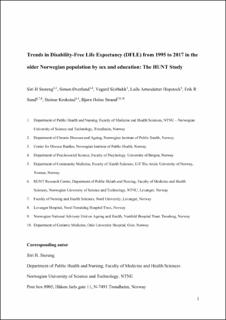| dc.description.abstract | Aim:
Understanding whether increasing Life Expectancy (LE) translates to improved health and function among older adults is essential, but results are inconclusive. We aimed to estimate trends in Disability-Free Life Expectancy (DFLE) in the older Norwegian population by sex and education from 1995 to 2017.
Method:
National life table data were combined with cross-sectional data on functional ability for 70+ year-olds from the population-based Trøndelag Health Surveys 2-4 (1995–1997, 2006–2008 and 2017–2019) (n=24,733). Self-reported functional ability was assessed on a graded scale by a combination of Instrumental Activities of Daily Living (IADL) such as paying bills, going out or shopping (mild disability) and Personal Activities of Daily Living (PADL) such as washing, dressing or eating (severe disability). LE, DFLE, Mild-Disability LE and Severe-Disability LE at age 70 were estimated by the Sullivan method.
Results:
From 1995 to 2017 DFLE at age 70 increased from 8.4 to 13.0 years in women, and from 8.0 to 12.1 years in men. DFLE increased in the basic and high educational groups, but more so in the high educational group among men. Educational inequalities in years spent with disability however, remained low.
Conclusions:
From the mid-1990s and over the past three decades both LE and DFLE at 70 years increased in the older Norwegian population, for both men and women, and across basic and high educational levels. Educational inequalities in DFLE increased, especially in men, but years spent with disability were similar across the three decades. | en_US |
